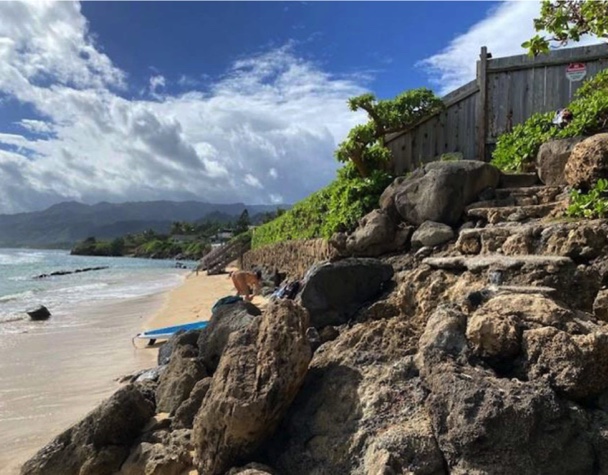On March 8, the state Board of Land and Natural Resources approved a 25-year, non-exclusive easement and immediate right-of-entry permit to Western Community Crossroads LC for a 710-square-foot rock revetment in Lāʻie, Oʻahu.
The revetment spans the front of the property held by Western Community Crossroads and that of three other owners. According to a notarized letter from the property’s previous owner, the revetment’s construction in “the 1962 to 1963 timeframe” predated the establishment of the Conservation District, which would make the seawall a non-conforming use.
The Department of Land and Natural Resources’ Office of Conservation and Coastal Lands stated in a September 6, 2023 letter to the applicant that the office was unable to confirm the legality or non-conforming status of the revetment and stairs to the beach. “Consequently, DLNR cannot prove the encroaching rock revetment and stairs are Conservation District violations. Should the OCCL find that the encroaching structures were built without permits, within the Conservation District after 1964, the OCCL may reconsider this finding.”
“OCCL’s evaluation criteria would support a disposition request being processed for the encroachment area. The subject revetment’s construction date cannot be determined based on the gathered information. Should the OCCL find that the structure has been significantly altered since it was originally constructed, the OCCL may reconsider this finding,” the letter stated.
The OCCL also found that removal of the revetment and stairs would “not improve beach resources and could cause property damage without concurrent removal of the entire revetment fronting the three parcels to the south,” according to a report to the board by the DLNR’s Land Division.
The Land Division “supports this disposition request solely on OCCL’s determination that it would support processing of a disposition request,” its report stated.
In explaining his office’s position, OCCL administrator Michael Cain told the board that on any application for a shoreline structure in the Conservation District, “we keep the burden on the landowner. When there’s a violation, that burden is on us.”
The OCCL was unable to find any authorizations for the revetment, but noted that a 2007 survey showed the revetment to be mauka of the shoreline, and, therefore, under county jurisdiction.
“On the burden of proof question, this is not an enforcement action,” board member Aimee Barnes said.
Cain replied that his office was asked to concur whether the revetment was a non-conforming structure.
“With non-conforming structures, there’s not a question of whether I like it or not. I’m obligated to follow the law, which allows for repair of non-conforming structures. … [Current] state law is that we do not armor shorelines where there are sandy beaches unless there’s a public purpose,” he added.
Board member Riley Smith supported the proposed easement. He said the beach area behaves much differently in other areas where the Land Board has rejected shoreline armoring efforts.
“To me, the message to a buyer is you gotta do due diligence. There may be different circumstances … that are gonna result in different outcomes that may change from time to time. So take your chances when you buy property next to the ocean. … I’m comfortable approving this one because there’s a whole lot of documentation here including that letter … that gives a reasonable defense on the timing [of the revetment construction],” he said.
Board member Kaiwi Yoon added that he was glad the reasons for approving this revetment were on the record. “I’m glad that we’re now armed to respond [to the community] in a manner that’s fair and consistent with the board’s actions previous about armoring our coast,” he said.
The Land Board approved the Land Division’s recommendation to approve the easement and right-of-entry permit, although board member Barnes voted in opposition.
Barnes said that for such a contentious issue as shoreline hardening, she would like to see a higher bar of evidence. “Nothing personal. Just my take on this matter before us,” she said.
Should the easement also be approved by the state Legislature, the owners would be required to post a bond covering the cost of the revetment’s removal. That’s been estimated to be about $23,000.
— Teresa Dawson


Leave a Reply